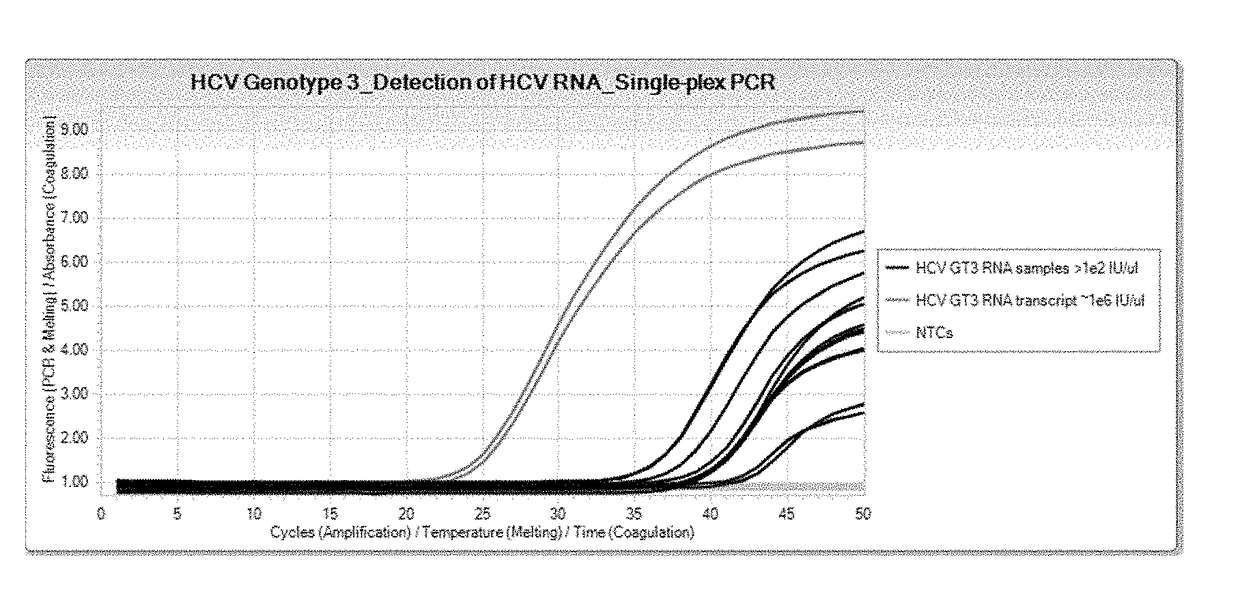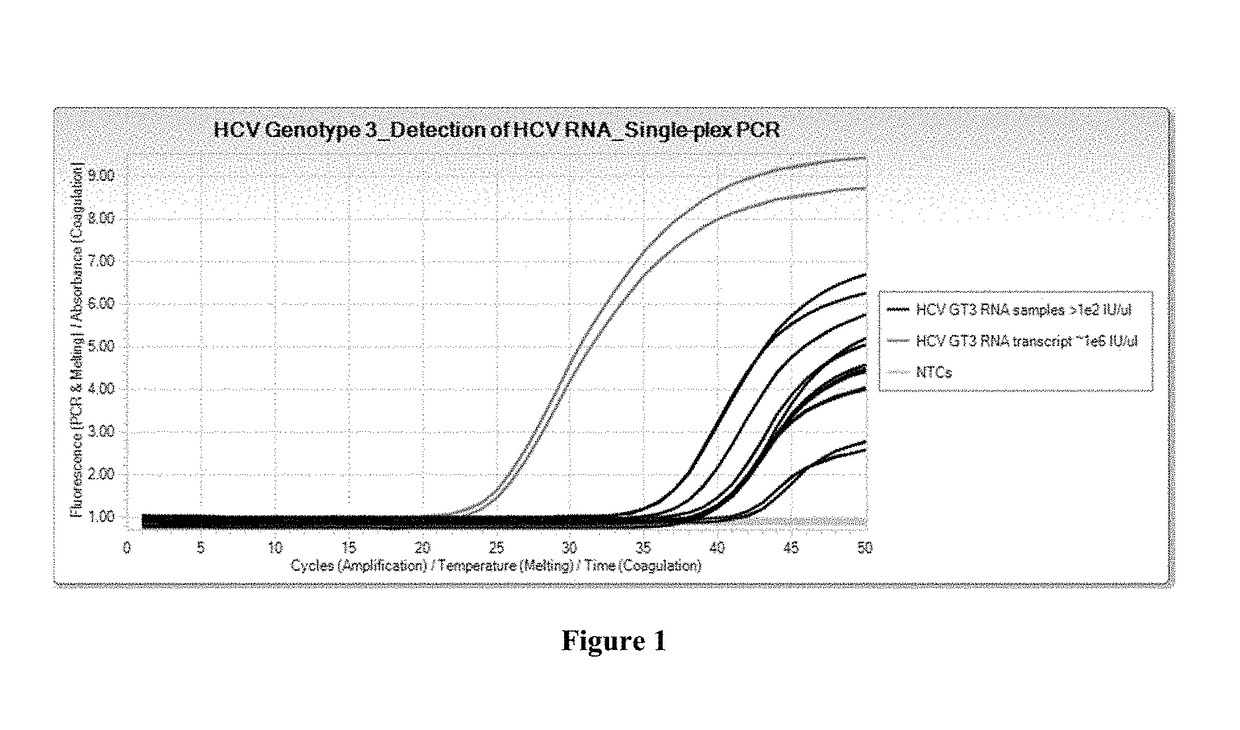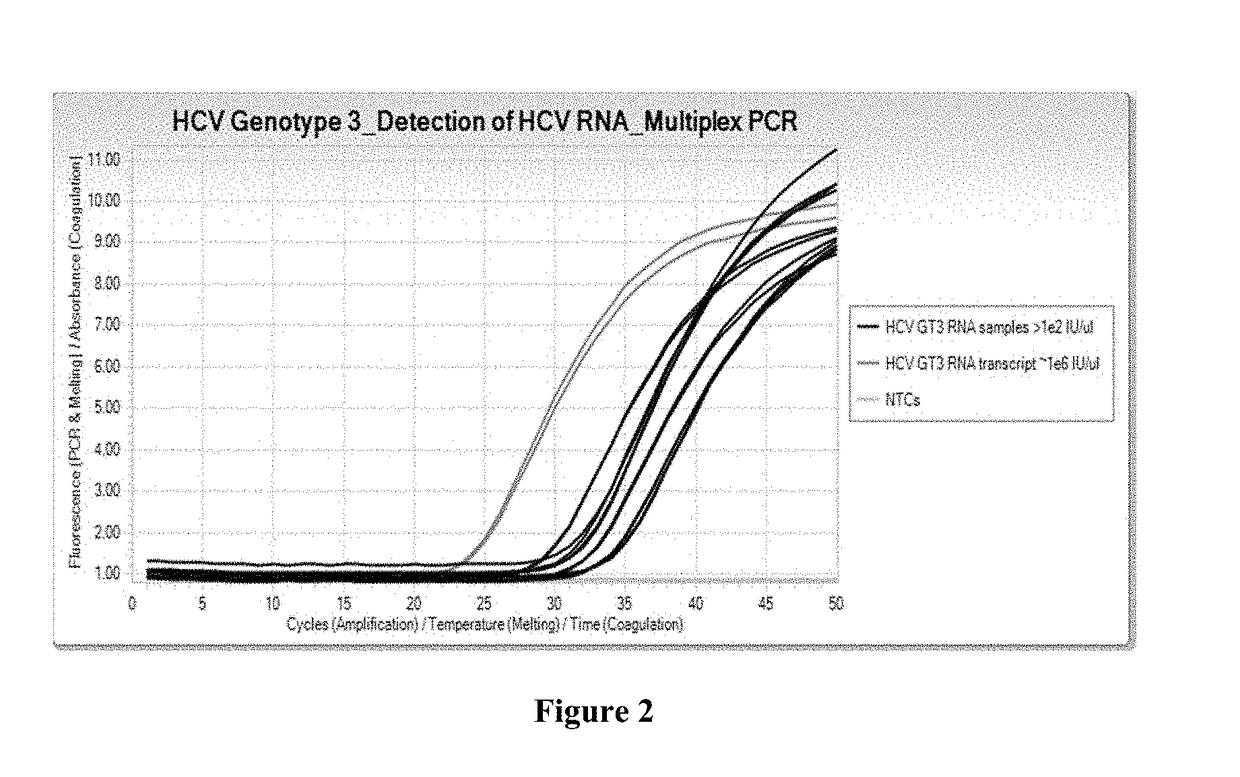Compositions and methods for detection of hepatitis c virus genotype 3
a technology of hepatitis c virus and detection method, which is applied in the field of in vitro viral diagnostics, can solve the problems of no vaccine to prevent hepatitis c infection, liver cancer, esophageal and gastric varices, etc., and achieve the effect of altering the stability of nucleic acid hybridization
- Summary
- Abstract
- Description
- Claims
- Application Information
AI Technical Summary
Benefits of technology
Problems solved by technology
Method used
Image
Examples
example 1
of HCV Genotype 3 by Real-Time PCR
[0085]RNA samples used for a singleplex real-time PCR assay were either HCV Genotype 3 viral RNA samples or HCV Genotype 3 RNA transcripts taken from HCV-infected plasma samples. Reagents used include Cobas® 6800 / 8800 generic PCR Master Mix, with the profile and conditions for use with the Cobas® 6800 / 8800, and using TaqMan® amplification and detection technology. Final concentration of oligonucleotides in the master mix ranged from 0.08 μM to 0.30 μM.
[0086]The oligonucleotides specific for HCV Genotype 3 used for the singleplex real-time PCR assay were SEQ ID NO:1 for the forward primer, SEQ ID NO:4 for the reverse primer, and SEQ ID NO:2 for the probe.
[0087]The results are shown in FIG. 1, which shows real-time singleplex PCR growth curves. These results demonstrate that the primers and probes (SEQ ID NOs:1, 2, and 4) detect the presence of viral RNA samples and RNA transcripts of HCV Genotype 3 in a real-time singleplex PCR assay.
example 2
of HCV Genotype 3 by Real-Time Multiplex PCR
[0088]RNA samples used for a multiplex real-time PCR assay were either HCV Genotype 3 viral RNA samples or HCV Genotype 3 RNA transcripts taken from HCV-infected plasma samples. Reagents used include Cobas® 6800 / 8800 generic PCR Master Mix, with the profile and conditions for use with the Cobas® 6800 / 8800, and using TaqMan® amplification and detection technology. Final concentration of oligonucleotides in the master mix ranged from 0.08 μM to 0.30 μM.
[0089]The oligonucleotides specific for HCV Genotype 3 used for the multiplex real-time PCR assay were SEQ ID NO:1 for the forward primer, SEQ ID NO:4 for the reverse primer, and SEQ ID NO:2 for the probe. Other oligonucleotides (i.e., primers and probes) specific for other HCV Genotypes from the commercially available Roche Cobas® HCV GT assay were also employed in this real-time multiplex PCR assay.
[0090]The results are shown in FIG. 2, which shows real-time multiplex PCR growth curves. Thes...
example 3
of HCV Genotype 3 by Real-Time Multiplex PCR
[0091]RNA samples used for a multiplex real-time PCR assay were either HCV Genotype 3 viral RNA samples or HCV Genotype 3 RNA transcripts taken from HCV-infected plasma samples. Reagents used include Cobas® 6800 / 8800 generic PCR Master Mix, with the profile and conditions for use with the Cobas® 6800 / 8800, and using TaqMan® amplification and detection technology. Final concentration of oligonucleotides in the master mix ranged from 0.08 μM to 0.30 μM.
[0092]The oligonucleotides specific for HCV Genotype 3 used for the multiplex real-time PCR assay were SEQ ID NO:1 for the forward primer, SEQ ID NO:3 for the reverse primer, and SEQ ID NO:2 for the probe. Other oligonucleotides (i.e., primers and probes) specific for other HCV Genotypes from the commercially available Roche Cobas® HCV GT assay were also employed in this real-time multiplex PCR assay
[0093]The results are shown in FIG. 3, which shows real-time multiplex PCR growth curves. These...
PUM
| Property | Measurement | Unit |
|---|---|---|
| temperature | aaaaa | aaaaa |
| temperature | aaaaa | aaaaa |
| temperature | aaaaa | aaaaa |
Abstract
Description
Claims
Application Information
 Login to View More
Login to View More - R&D
- Intellectual Property
- Life Sciences
- Materials
- Tech Scout
- Unparalleled Data Quality
- Higher Quality Content
- 60% Fewer Hallucinations
Browse by: Latest US Patents, China's latest patents, Technical Efficacy Thesaurus, Application Domain, Technology Topic, Popular Technical Reports.
© 2025 PatSnap. All rights reserved.Legal|Privacy policy|Modern Slavery Act Transparency Statement|Sitemap|About US| Contact US: help@patsnap.com



